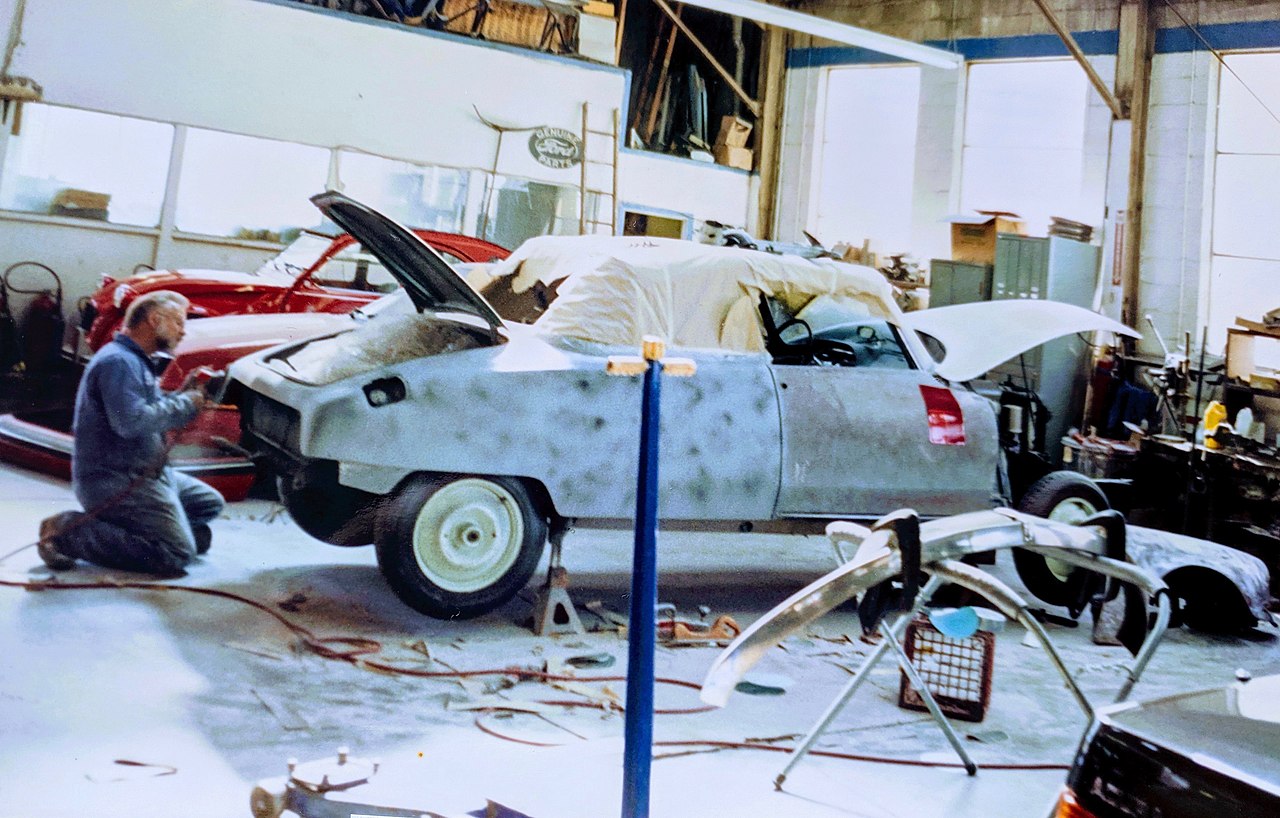News
Repair Work as Craft and Career: Insights from the Apprenticeship Journey in Classic Car Restoration

The following text was written by Ödül Bozkurt, Professor of Work and Employment at the University of Sussex Business School, and reflects her presentation at our Closing Conference, “Repairing Technology – Fixing Society?” from 13-14 October 2022 in Luxemburg.
While there is growing recognition of repair as sociologically significant and appreciation of repair activity as critical for sustainability transitions, to date there has been little discussion of repair work as a craft and career. We know little about the experiences of repair activity for repairers and hence do not have sufficient understanding of the rewards and pitfalls of working lives built around and through repair. This is especially the case for the consideration of repair as a professional activity and/or a labour performed in the context of paid employment. Such tendencies are somewhat ironically exacerbated by the emphasis on the DIY ethos in most contemporary discussions and celebrations of repair, where it is typically linked to lifestyle choices and especially orientations toward consumption. Many celebrations of repair skills, for example, welcome and solicit such skills among consumers themselves. Efforts to encourage shifts in perceptions of the “repairability” of artefacts and the appreciation of repair as a way of retaining and resuscitating “meaning” in objects are surely to be welcomed from the vantage point of both the survival of manual and craft skills and the drive towards sustainability. Yet repair work as a craft and career currently remains on the fringes of a growing and exciting field of discussion, one that potentially links it to another key policy and research priority, that of imagining the future of work and decent work for all.
The use-and-discard concept of the consumer economy, often predicated on designed-in obsolescence, has led to the widespread disappearance of repair work from advanced capitalist economies (Cooper, 2005; Carr and Gibson, 2016; Carr, 2017). As has been noted, “the ability to work with materials, and to make, repair or repurpose physical things, are vital skills” as natural resources become increasingly limited (Carr and Gibson, 2016: 298). The “vital nature” of such skills is more easily defended in conjunction with claims about the essence of being “human”, but there are very clear and well-known constraints on the returns of material repair work. As a consequence, where repair exists or survives in advanced capitalist economies, it is often as a hobby or leisure activity, as there is simply not sufficient return on the skilled labour of repair as a “craft” in monetary terms. The labour-intensive and location-specific nature of the vast majority of repair – i.e. the difficulty in outsourcing repair to low labour cost areas – typically makes it expensive relative to the purchase of new goods.
Yet repair work continues to be conducted in a myriad of ways for a very wide range of objects and is therefore found in highly variable occupational and employment settings. In this context, car repair deserves attention when attempting to gain a broader understanding of repair and offers lessons in chronicling the transformation of repair processes and therefore repair skills. Despite the growth of “unrepairability”, cars are still the most regularly repaired mass produced goods (Borg, 2007; Dant, 2010; Edgerton, 2006). Car repair involves craft as it retains a “human, artisanal character” (Dant, 2010) and experienced mechanics may be respected as “craftsmen” (Brockmann, 2010:67). Yet certainly in the UK car repair remains poorly paid and associated with poor social status, with training in this field typically attracting relatively uneducated young boys from disadvantaged backgrounds. Even highly specialist heritage vehicle repair broadly remains the “dirty work” that characterises car repair in general. Interestingly, despite the highly controversial nature of cars as environmentally problematic technology, car repair also provides among the highest number of “circular jobs”, as seen in attempts to record such occupations (Circular Jobs Monitor, 2022)
The classic car is a particularly evocative repair object. It combines the “mystique” of the car with the essence of heritage industries, where repair work is crucial for both the survival of heritage objects and the valorisation of these objects. The craft of repair in heritage is linked to highly evocative, meaningful and symbolically intense repair objects, but typically studies of heritage industries per se do not step back to focus on the material and subjective experiences of repair workers. In the UK, heritage motoring is among the most substantial heritage sectors, with over 850,000 historic vehicles needing service to maintain their roadworthiness and appearance. The popularity of classic vehicles has been bolstered by a growing number of cultural products in various media outlets, with classic motoring events attracting over five million participants annually (FBHVC, 2016). In 2016 it was estimated that 31,100 full-time or part-time paid jobs were involved in classic vehicle maintenance, repair and restoration, with 3,800 trainees or apprentices added to this craft workforce since 2011 (FBHVC, 2016: 59). Coupled with the aging workforce, the growth of the sector has led to anticipated skilled labour shortages and a widely perceived need for more systematic and widespread training.
An ongoing study of the “trailblazer” apprenticeship programme launched in 2018 to address this expected skills shortage offers insights about repair work as a craft and career. The programme offers training in heritage vehicle engineering, with specialist knowledge and hands-on competence in the crafts of repair and restoration across a range of heritage vehicles. The bespoke programme was developed jointly with input from employers, the federation of enthusiast clubs and a dedicated training provider. The three-year course involves working with a specialist employer and attending ten one-week teaching blocks a year, held at the purpose-built workshop located at a motoring heritage site. The study followed an incoming cohort of apprentices from their first teaching week in autumn 2018 until their final week of teaching just before Christmas 2021. At this point, from an initial cohort of 13, seven apprentices remained, with one having joined midway through and one having transferred to the bodywork pathway opened afterwards.
The apprentices’ lived experiences of their current work as well as their imagined ideas about their future employment offer insights into how repair work embedded in craft offers elements of “good work”, while also indicating where tensions, shortcomings and constraints arise. Seven elements of “good work” will be discussed with respect to these repair workers and their repair careers: employment contracts, namely the fact that good work should “give people the means to securely make a living”; work-life balance and the fact that this should be attainable; job design, the nature of work and the extent to which these offer “opportunities to develop skills and a career, and ideally [provide] a sense of fulfilment”; relationships at work, that is, providing “a supportive environment with constructive relationships”; employee voice, whereby good work offers employees “the voice and choice they need to shape their working lives”; and finally, health and well-being, in that good work “enables staff to be physically and mentally healthy” (CIPD 2022). Following on from a previous study of college learners where the attraction to repair was observed to have been anchored around “love” (Bozkurt and Cohen 2019), this study of apprentices who enact their careers through on-the-job training complements our understanding of the attractions of repair with an understanding of the elements of job quality in practice.
References
Borg, K. L. (2007). Auto Mechanics. Baltimore, MD: Johns Hopkins University Press.
Bozkurt Ö and R. Cohen (2019). “Repair work as good work: craft and love in classic car restoration training”, Human Relations 72(6): 1105-1128.
Bozkurt, Ö (2016). “To drive Bond-style classic cars into the future, Britain needs a new generation of Qs”. The Conversation. https://theconversation.com/to-drive-bond-style-classic-cars-into-the-future-britain-needs-a-new-generation-of-qs-63467
Brockmann, M. (2010). Identity and apprenticeship: The case of English motor vehicle maintenance apprentices. Journal of Vocational Education & Training 62(1): 63–73.
Carr, C. (2017). Maintenance and repair beyond the perimeter of the plant: Linking industrial labour and the home. Transactions of the Institute of British Geographers 42(4): 642–654.
Carr, C. and Gibson, C. (2016). Geographies of making: Rethinking materials and skills for volatile futures. Progress in Human Geography 40(3): 297–315.
CIPD (2022). The good work index. Available at https://www.cipd.co.uk/knowledge/work/trends/goodwork#40068
Circular Jobs Monitor (2022). https://www.circular-jobs.world/
Cooper, T. (2005). Slower consumption: Reflections on product life spans and the “throwaway society”. Journal of Industrial Ecology 9(1–2): 51–67
Dant, T. (2010). The work of repair: Gesture, emotion and sensual knowledge. Sociological Research Online 15(3): 1–24.
Edgerton, D. (2006). The Shock of the Old: Technology and Global History Since 1900. London: Profile Books.
FBHVC (Federation of British Historic Vehicle Clubs) (2016). The 2016 National Historic Vehicle Survey Structural Report. Wallingford: FBHVC. Available at: http://www.fbhvc.co.uk/research/



